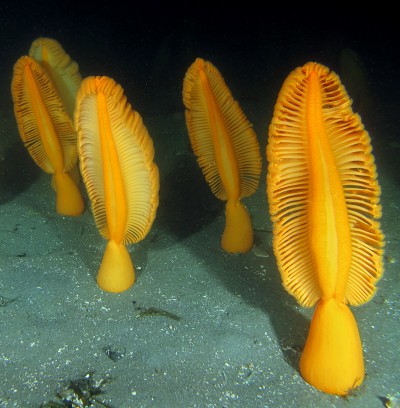
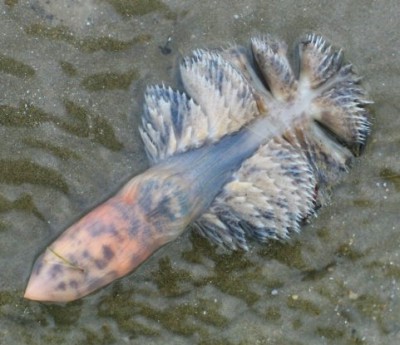
Sea Pens
Phylum: CNIDARIA
Order: PENNATULACEA
PHOTO
Upper: A group of Ptilosarcus gurneyi at Possession Point beach, Whidbey Island, 50 feet, California, Eastern Pacific Ocean, 19 August 2009, Sandy slope. Photographer: Jan Kocian.
Lower: One dying Sea Pen washed ashore after storm. Armstrong Beach, On shore, Queensland, Australia, Coral Sea, 10 February 2010, Length: Approx 10 cm. Photographer: Sharyn Reen.
Sea pens are cnidarians or coelenterates, related to sea anemones, corals and jellyfish. Each 'animal' is a colony, with a fleshy anchor which sticks down into the mud or sand, and an upper 'feather-like part with layers of flaps which can expand out into the water. At the edge of the flaps are a row of polyps, which look like small sea anemones. They live offshore in sheltered bays, feeding on small organisms in the water. Some species are eaten by arminid nudibranchs. See messages attached to the Armina californica for many examples, in particular message #23276.
See also message #23267 for photos of Armina semperi feeding, and close-up photos of the sea pen polyps.
Rudman, W.B., 2010 (March 9) Sea Pens. [In] Sea Slug Forum. Australian Museum, Sydney. Available from http://www.seaslugforum.net/find/seapens
Related messages
Re: Sea pens [2]
March 15, 2010
From: Leanne and David Atkinson


Concerning message #23276:
Hi Bill,
You asked for photos of Sea Pens. We get several types of Sea Pen here so I will send some more messages showing the different varieties [see messages #23326, #23328]. They are something we see in the Port Stephens-Great Lakes Marine Park regularly over all of the dive sites. Here are our second series of photos. The first photo shows a Sea Pen stalk with Polyps out. It was taken at Fly Point, Port Stephens-Great Lakes Marine Park, Port Stephens, NSW Australia in 8metres of water. The next two show Sea Pens from The Pipeline with a close up of the Polyps. Both of these were taken at The Pipeline, Nelson Bay Port Stephens.
Locality: The Pipeline, Nelson Bay, Port Stephens, 8metres, New South Wales, Australia, Pacific Ocean, 07 March 2009, Sandy bottom with scattered Sea Pens, sponges, bryozoans, gorgonias, soft corals, hydroids and ascidians. Length: 30mm. Photographer: Leanne and David Atkinson.
Hope these are of interest.
Yours sincerely,
Leanne & David Atkinson
atk@hunterlink.net.au
Atkinson, L. & D., 2010 (Mar 15) Re: Sea pens [2]. [Message in] Sea Slug Forum. Australian Museum, Sydney. Available from http://www.seaslugforum.net/find/23327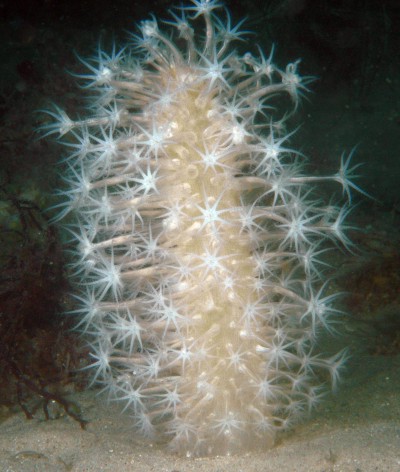
Dear Leanne and David,
This is one of a small group of sea pens which have a sausage-shaped body with the polyps radiating out in all directions. They differ from the more speciose 'feather-shaped' species which gave the group the name 'sea pen' because of their resemblance to quill pens.
In my comment to your earlier message [#23326] I wondered just how specialised species of Armina would prove to be in their food choices when sufficient observations were made. Interestingly this sea pen seems to be the one that Armina sp. 9 is feeding on in an earlier message of yours [#13514]. Perhaps it would be a nice study to do on the Port Stephens area. Although we cant name either the sea pens or the Armina species at present, they are sufficiently distinct from eacch other to identify and give them temporary names.
Best wishes,
Bill Rudman
Re: Sea pens [1]
March 15, 2010
From: Leanne and David Atkinson
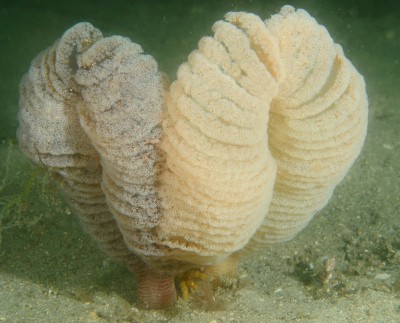
Concerning message #23276:
Hi Bill,
You asked for photos of Sea Pens. They are something we see in the Port Stephens-Great Lakes Marine Park regularly over all of the dive sites. Here are a series of photos. One shows a pair of Sea Pens that are slightly different shades and the lower one shows one almost compleely buried. Both of these were taken at The Pipeline, Nelson Bay Port Stephens. The upper one was taken at Little Beach, Port Stephens-Great Lakes Marine Park, Port Stephens, NSW Australia in 8metres of water.
Locality: The Pipeline, Nelson Bay, Port Stephens, approximately 8metres, New South Wales, Australia, Pacific Ocean, 07 February 2009, Sandy bottom sponges, bryozoans, gorgonias, soft corals, hydroids and ascidians. Length: 30 mm plus. Photographer: Leanne and David Atkinson.
We get several types of Sea Pen here so I will send some more messages showing the different varieties.[see messages #23327, #23328, #23329]
Hope these are of interest.
Yours sincerely,
Leanne & David Atkinson
atk@hunterlink.net.au



Dear Leanne and David,
Thanks very much for your messages. It is valuable when looking for nudibranchs to have an idea of what their prey looks like, because often that is where they are to be found. It will also be interesting to discover whether species of Armina restrict themselves to one species of sea pen or have a broader diet. Apart from studies on some northern hemisphere species, we know little about their biology.
Best wishes,
Bill Rudman
Armstrong Beach, Queensland. What is it?
February 22, 2010
From: Sharyn Reen
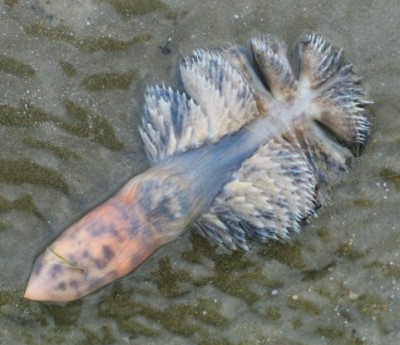
Hi,
I would really like to find out the ID of this fellow I found whilst walking our local beach. I have tried to find out about it online and have found many spectacular looking creatures but none quite like this one.
Locality: Armstrong Beach, On shore, Queensland, Australia, Coral Sea, 10 February 2010, Found a couple of these washed ashore after rough weather.. Length: Approx 10 cm. Photographer: Sharyn Reen.
Thank you for your help.
Sharyn Reen
photosharyn1@hotmail.com
Reen S.L, 2010 (Feb 22) Armstrong Beach, Queensland. What is it?. [Message in] Sea Slug Forum. Australian Museum, Sydney. Available from http://www.seaslugforum.net/find/23252Dear Sharyn,
This is not a sea slug, but since some sea slugs eat your mystery find, I'll break my rules and give you a short answer. It is a Sea pen [Order Pennatulacea] which are animals related to sea anemones, corals and jellyfish. Each 'animal' is a colony of smaller animals. The fleshy bare cylinder is an anchoring rod, which is normally embedded into the mud or sand. The feathery part consists of layers of flaps, which can expand out into the water, and at the edge of the flaps are a row of small animals called 'polyps', which look like small sea anemones. Sea Pens live offshore in sheltered bays. I suspect your animal has been 'uprooted' by heavy seas and washed ashore.
One genus of sea slugs [Armina] feed on sea pens. Have a look at the messages on the Armina califomica page for more photos of sea pens in a slightly more healthy condition than yours. If any one has a nice photo of a healthy sea pen it would be good to add it to the Sea Pen page.
Best wishes,
Bill Rudman
Sea Pens from Western Australia
July 25, 2006
From: Beth Turnbull
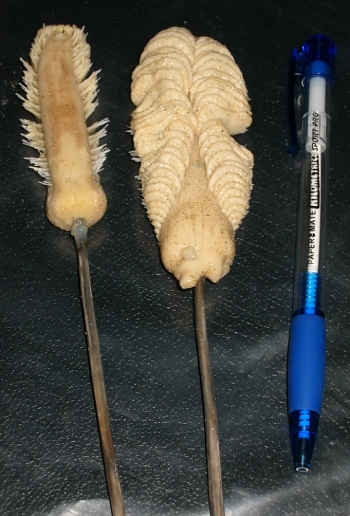
Hi
I found this on the sand just above the low tide mark on Secret Harbour Beach Western Australia. I thought it may have been just a piece of rubbish until I found the second one.
The white flesh part feels like a muscle. The grey and black root feels like a stick.
Locality: Secret Harbour, Shoreline, WA, Australia, Indian Ocean, 23 July 2006, On the sand just above the low tide mark. Length: Body 8cm, Body and root 30cm. Photographer: Beth Turnbull.
There was a lot of weed on the beach and shells, much more than we normally have on this protected beach.
Can you tell me what it is.
Thanks
Beth
beth.turnbull@bigpond.com
Turnbull, B, 2006 (Jul 25) Sea Pens from Western Australia. [Message in] Sea Slug Forum. Australian Museum, Sydney. Available from http://www.seaslugforum.net/find/17207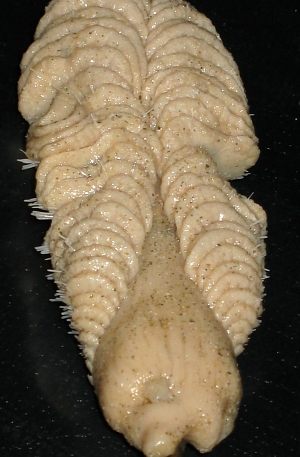
Dear Beth,
I have a lot of trouble keeping up with queries about real sea slugs so I am reluctant to answer messages on other 'sea curiosities', but this animal - yes it is an animal - has some relevance to sea slugs. Some arminid nudibranchs actually feed on these.
It is a sea pen, and you will find photos of a slightly more alive animal in Jan Kocian's message #14913 of the Californian nudibranch Armina californica feeding on one.
Sea pens [Order Pennatulacea] are cnidarians or coelenterates, related to sea anemones, corals and jellyfish. Each 'animal' is a colony, and the stick-like thing, is an anchoring rod, normally covered in flesh, which sticks down into the mud or sand. The white part with layers of flaps, can expand out into the water, and at the edge of the flaps are a row of polyps, which look like small sea anemones. Sea Pens live offshore in sheltered bays. Your mention of lots of shells and weed on the beach suggest that these animals have been uprooted by heavy seas
Best wishes,
Bill Rudman
